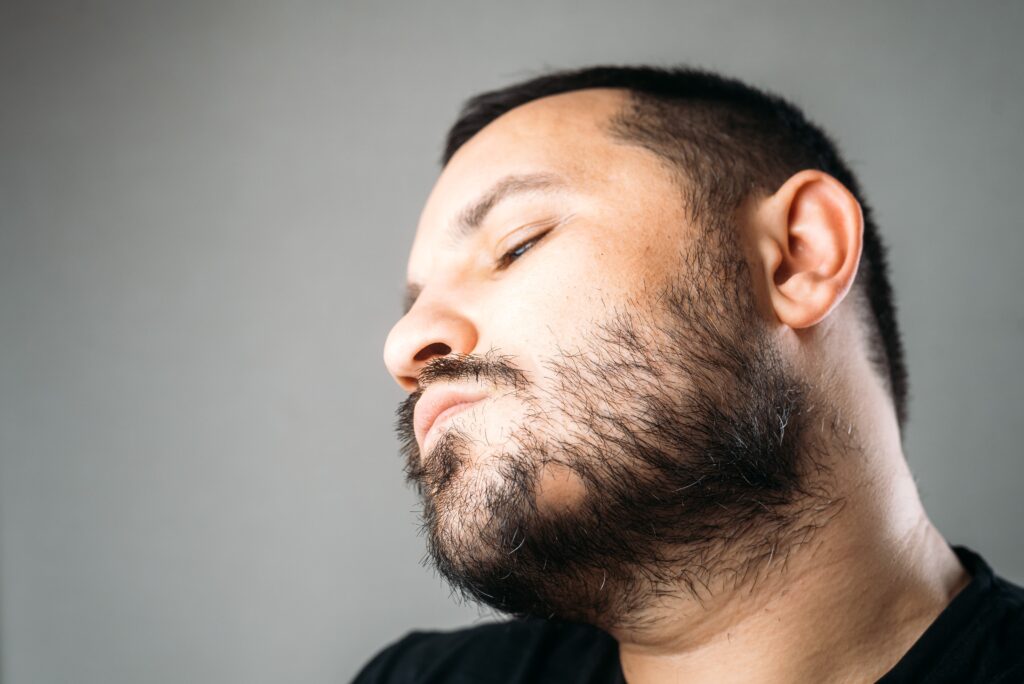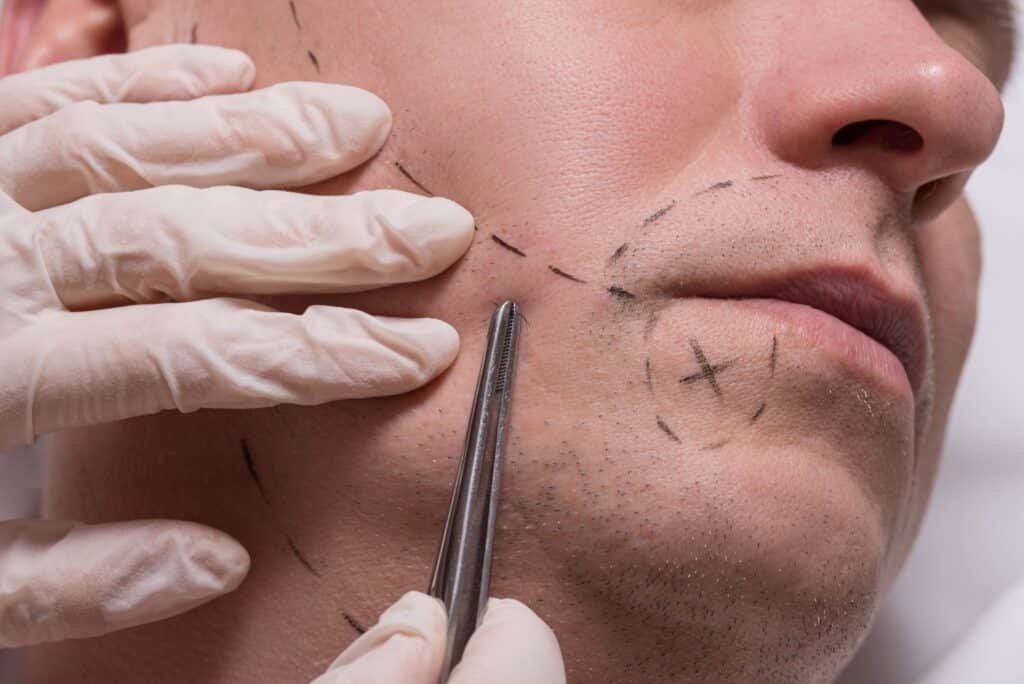A condition that causes hair loss, alopecia barbae specifically targets the beard area. You might compare this condition to its annoying cousin, alopecia areata. The difference is it causes uneven bald patches of hair loss in your beard instead of your scalp. Beard hair loss is usually a result of an autoimmune disease.
The immune system attacks your hair follicles, leading to patchy baldness. Beard alopecia symptoms often manifest in the jawline area in small circular patches. It may also appear on the cheek, sideburn, and below the mouth.
While the exact causes are unknown, there are many predisposing factors. Stress, gender, genetics, specific drugs, etc., can significantly exacerbate beard hair loss.
Although it isn’t a life-threatening condition, it can have a significant impact on a person’s mental health. In this comprehensive blog post, we’ll dive deeper into alopecia barbae, exploring its causes, symptoms, diagnosis, and treatment options in detail. Understanding this condition is crucial for those affected, as it can have a profound impact on self-esteem and emotional well-being.
How Does Alopecia Barbae Work?

Beard hair loss is a form of alopecia areata that causes specific hair loss in the beard area. Family history can raise the risk of developing alopecia barbae and other autoimmune disorders.
Infections or other underlying conditions may also contribute to beard hair loss. In most cases, the first signs of beard alopecia are small, circular patches of hair loss in the beard region.
Over time, these patches can get larger and merge. Ultimately, this results in more significant areas of bald patches or a complete lack of facial hair. Researchers are still studying the mechanisms for beard hair loss. While the exact process is unknown, there are many plausible theories.
There are three distinct phases that every hair follicle goes through. They are known as:
- The anagen phase
- The catagen phase
- The telogen phase.
In beard alopecia, there is premature termination of the anagen phase. This process leads to excessive beard hair loss during the telogen phase.
Another theory is a deficiency or malfunction of regulatory T-cells. Your body’s white blood cells attack its hair follicles and trigger hair loss. Sometimes, the autoimmune reaction might damage or scar the hair follicles.
This process can impede hair regrowth even after treatment of the underlying sickness. A better understanding of beard hair loss can be helpful to control it effectively.
What Are the Signs of Alopecia Barbae?
Compared to male pattern baldness, alopecia barbae is easily identifiable for its unique appearance. Typically, the patches of hair loss are usually the size of a 10p to 50p coin. It’s not unusual for multiple hair loss sites to develop. The symptoms of beard hair loss may include:
Exclamation marks
One of the first signs that may be present is the appearance of “exclamation mark hairs.” These hairs gradually decrease in size as they approach the root. The immune system’s attack on the hair follicle is the cause of the appearance of exclamation marks.
Beard Hair loss
During the progression, there may be some bald patches on your face. These can be small and circular or larger and irregular in shape. As the hair follicles become disabled, they cannot produce new hair. This results in bald spots in your beard area.
Alopecia Totalis
Alopecia barbae commonly presents as localized patches of hair loss. Sometimes, the hair loss extends to other areas like the scalp, eyelashes, or eyebrows. This condition is known as alopecia totalis or alopecia universalis.
Unpredictable Hair Regrowth
In some cases, hair may regrow spontaneously in the affected areas. However, this is temporary, and the hair loss cycle begins again.
How to Diagnose Alopecia Barbae?

Alopecia barbae diagnosis includes a combination of physical examination and medical history evaluation.
To identify areas of hair loss, the physician will perform a visual examination of the beard region. Additionally, the physician will examine the pattern of hair thinning. They may inquire about any familial history of alopecia areata or autoimmune diseases.
The medical history evaluation will also ask about specific medications. It is possible to carry out additional diagnostic procedures such as:
- Skin biopsy: A skin biopsy examines the hair follicles under a microscope to rule out fungal infections or scarring alopecia.
- Blood tests: A blood test can detect an autoimmune disease or underlying medical conditions that may contribute to hair loss.
What are the Best Alopecia Barbae Treatments?
Beard hair loss is another form of alopecia areata. Treating alopecia areata is difficult, but some options may include:
- Topical creams/ointments with corticosteroids can reduce inflammation
- Steroid injections directly into affected areas
- Topical interventions like Minoxidil allow hair to grow
- Oral medications like JAK inhibitors suppress the overactive immune response
- Immunotherapy adjusts the immune system’s hair follicle attacks
- Light therapy uses specific wavelengths to stimulate hair growth
- Beard hair transplant for a permanent solution
Living With Alopecia Barbae
Neither alopecia barbae nor alopecia areata result in permanent hair loss. So, your hair loss will be temporary. Typically, this happens for 3-6 weeks, after which your beard hair will grow back. Even though it’s quick, someone may experience beard alopecia multiple times.
Cosmetic products like hair fibers or eyebrow powder can help camouflage bald patches. Some choose to wear hairpieces, wigs, or fake beards as another option. Treatment and self-care strategies can help you live fulfilling lives while managing this autoimmune condition.
Can Alopecia Barbae Come Back After Treatment?
Some people may go years or even decades before experiencing another flare-up. Others have a more rapid cycling pattern with shorter hair regrowth periods. Stress management and a healthy lifestyle may help extend the periods of remission. But most will experience recurrent episodes of beard hair loss over their lifetime.
Get Alopecia Barbae Treatment from a Leading Hair Restoration Clinic

A cutting-edge beard hair transplant can permanently restore a whole, even beard. During a DHI transplant, specialists manually transplant beard hair grafts into bald areas individually. This precision placement supports a more natural look, with a 98% hair regrowth rate.
Beard transplantation in Turkey costs considerably less than similar procedures performed elsewhere globally. Dr. Levent Acar from Cosmedica Hair Clinic specializes in alopecia barbae treatment. As a certified DHI Sapphire FUE hair transplant specialist, he has treated over 20,000 clients from around the globe.
You can book a free consultation to develop a customized treatment plan for your beard hair loss. Proven alopecia barbae treatments like a cutting-edge beard transplant can help you regain a fuller beard.
